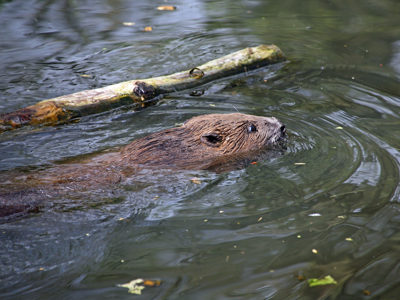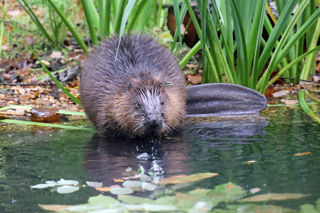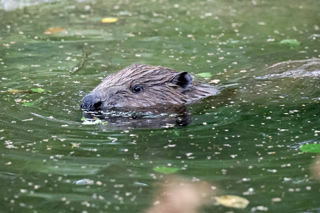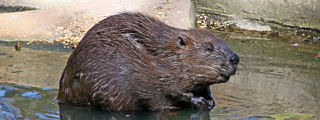
Eurasian Beaver
Castor fiber
Beavers are the largest rodent species native to Eurasia (11-30kg). They can range 80-100cm in body length, with their flattened tails being an additional 25-50cm long. Their stocky bodies, large flat tails and rich brown fur coats makes them easily recognisable.

Habitat
Freshwater habitats (lakes, rivers, swamps) surrounded by woodland areas. Freshwater systems with still or slow flowing waters are preferred.

Behaviour
Nocturnal, social species living in family groups of up to 12 individuals. Beavers are a keystone species: they help to support and maintain the ecosystem they live in as well as having a positive effect on many other organisms in the community. The construction of beaver dams, burrows and lodges by beaver colonies also benefit many other species by creating wetlands (habitats for water voles, otters, and water shrews). Their feeding habits on nearby trees benefits birds and other mammals by providing cover. Beaver dams also improve water quality, which has a beneficial effect on fish and other aquatic species.

UK Status
Beavers became extinct in the UK in 16th century. In 2001, a wild beaver population became established on River Tay in Scotland. In a 2017-2018 survey, the Tayside population was estimated to have reached 300-550 beavers and was subsequently afforded legal protection in Scotland. In 2009, a government report recommended that beavers be considered for reintroduction into the wild in England and a trial was established in Devon. In October 2022 the status of beavers was reinstated as 'native' and are now a protected species. Populations are re-establishing in Devon, Kent and throughout Britain.
Distribution
Once widespread throughout Europe. Current range is much smaller (map) across continental Europe, Scandinavia, and into Russia.
Diet
Herbivorous. In summer, beavers feed on aquatic plants, bark, leaves, roots and agricultural crops in some areas. In the winter, their diet mainly consists of woody vegetation such as willow, birch and aspen trees.
Threats
Historical threat was overexploitation and hunting for fur, meat and castorem (a scent gland secretion). Habitat loss of wetland habitats also contributed.
Wildwood inside information
A pioneering project was established in 2001 in collaboration with Kent wildlife trust using beavers to restore and manage a rare wetland nature reserve in Ham Fen. For more information, visit our Conservation projects page.
Many conservation organisations throughout England, Wales and Scotland are exploring beaver reintroduction projects in order to utilise their “ecosystem engineer” role.
At Wildwood our beavers have their own den with viewing panes so you can see them without disturbing them. They come out for a swim when they are fed, usually late in the afternoon. Stay very quiet and look for dark ripples and bubbles in the water, it might be a beaver ready to surface.
Family facts
- Beavers have poor eyesight, but have a transparent eyelid that enables them to see underwater.
- Beavers can remain underwater for about 15 minutes.

